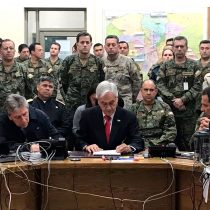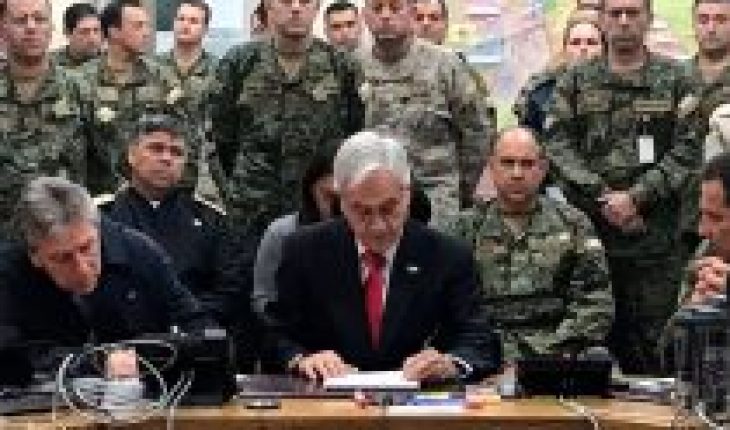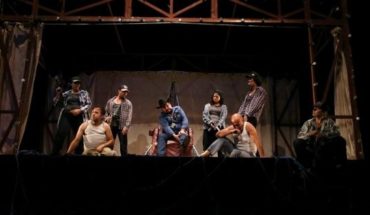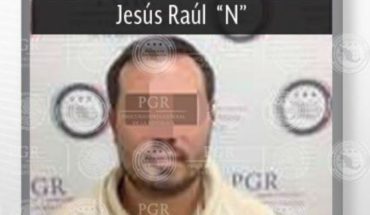
“We are at war against a powerful, relentless enemy, who respects nothing or anyone and who is willing to use violence and crime without any limit, who is willing to burn down our hospitals, the Metro, the supermarkets, for the sole purpose of producing as much damage as possible.”
This phrase uttered by President Sebastián Piñera on October 20, 2019, will hardly be erased from history. Never before had a head of state in democracy spoken of war, and in his words there seemed to be convictions that were not held in the days before, such as when, in full social outburst and while burning the facade of Enel’s building, Piñera had been photographed eating pizza on his grandson’s birthday.
Before the intervention of the Head of State, former Interior Minister Andrés Chadwick, in a message at the Palace of La Moneda, had held a similar idea and in the same tone: “Let’s not kid ourselves. We are facing a real escalation that is undoubtedly organized to cause serious harm to our country and to the lives of each of the citizens.”
What caused the President to be photographed surrounded by military personnel on the second day of the October revolt, which had already led to a social outburst?
Hours earlier, at the hands of the then Minister of Defense, Alberto Espina, the Representative had received a secret report, under the water seal of Intelligence, prepared by the Directorate of National Intelligence of the Army (DINE). It was Piñera’s Zeta Plan*.
Discarded reports
Twelve days before these interventions, exactly on October 8, the National Intelligence Agency (ANI) – led at the time by Luis Masferrer – evacuated the report “Call for a Week of Sabotage and Evasion of Public Transport DII/DI”. The report was ousted to the Ministry of the Interior, Carabineros, Metro, Ministry of Transport, Army and Navy, among other agencies of the intelligence network.
That document did not contain residual information, rather it referred to an anticipation of scenarios, with a certain degree of certainty that, one year after those events, it is paradoxical that the authority did not take them into account with due seriousness.
“In relation to the call made from the National Institute, around 50-100 students are expected to enter the Universidad de Chile metro station at 14:00 hours and skip the tourniquet in order to evade payment of the Metro service. To this, the hooded ones could be joined, those that would cause damage with launches of Molotov-like incendiary devices and structural damage to the public transport service, whether metro station or RED whereabouts, these most violent actions would take place, mainly in the external sectors of the station, not disarping the attack on buses”, described in the report.
In addition, he adds, “organizations from different sectors of the left and anarchists are projected to call for new demonstrations and calls for mass evasions against the rise of public transport, such as that of 14 October. Hotspots are Metro stations, especially those located in the central sector, and the frontis of the Ministry of Transport. These demonstrations could end with serious incidents, with a high probability of attacks on NETWORK buses. This call to Sabotage and Evasion adds the calls for solidarity made during the previous week, from the anarchist sectors, and the call for a black November in commemoration of Kevin Garrido, raising the alert for possible incendiary/explosive attacks by insurrectionary anarch groups, especially RED buses and whereabouts.”
The report concludes with the following warning: “In the same way, though less likely, no installation of explosive devices is ruled out (…) outside in or near the Metro, mainly at peak times. In this context, it is suggested to raise security and control measures at the highest risk points already mentioned.”
Six days later, a new report dated 14 October – sent to the same institutions – details about a dozen Metro stations that could be severely vandalized. Most of them burned.
The battalion of 600 Venezuelans
Already with the country practically on fire and President Piñera from La Moneda demanding information that gave clarity “to the blindness” in which he was, on October 20 a meeting was held in army units, attended by the First Representative, the now former Minister of Defense Alberto Espina; Javier Iturriaga, the military chief in charge of MRI security following the establishment of the State of Emergency, and the director of dine (Directorate of National Intelligence of the Army), General Guillermo Paiva, the same officer who in 2018 was involved in the controversial Operation Surveyor, where members of the institution and journalist Mauricio Weibel were made wiretaps.
At that meeting, Espina and General Paiva present Piñera with the DINE intelligence report. The message was shocking. The Army had become aware that Venezuelan and Cuban intelligences had been developing an “insurrectional offensive for Chile”.
Without giving details on how this “foreign intervention” had managed to permearse national intelligence without the Armed Forces being able to warn it, General Paiva noted in the report that the Bolivarian National Intelligence Service (SEBIN), which would be a cell of the G2 (Cuban Intelligence Service), said: “They would have for their operations in the interior of Chile a battalion of 600 clandestine agents, experts in urban guerrillas, who entered Chile as refugees, many of them trained in Cuban subversive schools such as Punto Cero”.
According to the Army, “Pedro Carvajalino, of the government chavista organization Zurda Konducta, would be one of the commanders of SEBIN/G2 in charge of the insurrectional offensive for Chile.
With this information, of which Espina did not hide his pride, Piñera gave the press conference – at this historical point – when he spoke of war.
What was not said at that time is that the chavista Zurda Konducta organization is actually a television program that drives Pedro Carvajalino, a youtuber and partying fan of the government of Nicolás Maduro, which uses its networks as a mechanism of political turmoil. One of the evidence of his participation in Chile, which the report provides, is a photograph that Carvajalino himself uploaded to his social networks, in an obvious Photoshop in which the toyman is seen with La Moneda in the background.
*The Plan Zeta it was an alleged plan by the Government of Salvador Allende to carry out a self-strike in order to impose on the force a Marxist government. The alleged existence of this plan was disclosed by the military who perpetrated the 1973 coup d’etre to justify the violence.





